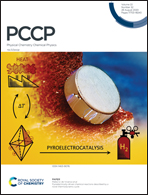The influence of alkyl chain branching on the properties of pyrrolidinium-based ionic electrolytes†
Abstract
Ionic liquids and plastic crystals based on pyrrolidinium cations are recognised for their advantageous properties such as high conductivity, low viscosity, and good electrochemical and thermal stability. The pyrrolidinium ring can be substituted with symmetric or asymmetric alkyl chain substituents to form a range of ionic liquids or plastic crystals depending on the anion. However, reports into the use of branched alkyl chains and how this influences the material properties are limited. Here, we report the synthesis of six salts – ionic liquids and organic ionic plastic crystals – where the typically used linear propyl chain substituent is replaced by the branched alternative, isopropyl, to form the cation [C(i3)mpyr]+, in combination with six different anions: dicyanamide, (fluorosulfonyl)(trifluoromethanesulfonyl)imide, bis(trifluoromethanesulfonyl)imide, bis(fluorosulfonyl)imide, tetrafluoroborate and hexafluorophosphate. The thermal and transport properties of these salts are compared to those of the analogous N-propyl-N-methylpyrrolidinium and N,N-diethylpyrrolidinium-based salts. Finally, a high lithium salt content ionic liquid electrolyte based on the bis(fluorosulfonyl)imide salt was developed. This electrolyte showed high coulombic efficiencies of lithium plating/stripping and high lithium ion transference number, making it a strong candidate for use in lithium metal batteries.



 Please wait while we load your content...
Please wait while we load your content...